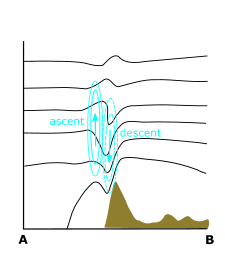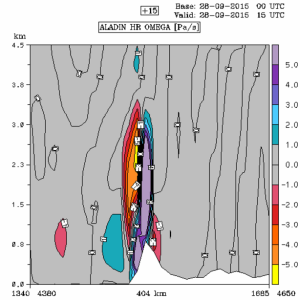Typical Appearance In Vertical Cross Sections
In all strong to severe bora cases, the most prominent feature in vertical cross sections is the hydraulic jump signature, occurring along the flow. In a hydraulic jump a mountain wave steepens until it breaks, which can be seen in the vertical distribution of the potential temperature (Θ) above the top of Mt. Velebit and the uppermost part of the slope on the leeward side.
Downward sloped isentropes with very steep fall can be found directly above the mountain slope on the leeward side.
Since the flow is parallel to the isentropes, the denser they are, the higher the wind speed. The mountain waves are located above the leeward mountain slopes and they are steepest just past the mountain tops. The downward sloped isentropes are followed by upward sloped ones, which is clearly seen in the ω cross section with maxima of descending and ascending motions very close to each other.
Another important feature is the flow of dry and colder air across the mountain chain, visible in relative humidity cross sections. Dry air flows across the mountains and falls down toward the sea. This usually causes cloud dissipation and clear skies in most bora cases.
In a cross section covering high mountains on the upwind side, wind velocity is greater in the upper layers, whereas on the lee side the wind is strongest in the lowest part of the troposphere, up to 1 or 1.5 km above the ground. The wind is at its strongest directly above the mountain slope and immediately next to it at the leeward side due to the hydraulic jump, which dissipates energy downstream. There are, however, many locations where the strongest wind is blowing through the mountain passes or gaps. In those locations bora can have large wind speeds much further down (close to the ground) and quite far away from the mountain, over the sea because there is no hydraulic jump to dissipate the energy. The dynamics of those bora cases are mainly mesoscale and are not necessarily related to the mountain wave breaking (the latter pertains to most severe bora cases). Instead, they arise from gap flows through mountain passes. Such flows are often generated and enhanced by upwind pools of relatively cool air basins near the coastal mountains.
Large values of downward vertical velocity are present in a very narrow area just above the top of the mountain and the uppermost part of the leeward slope. A very narrow area of strong upward motion is found next to it.
| Location of the cross section |

|
|
28 September 2015/15.00 UTC - Vertical cross section; white: potential temperature (K); shades: relative humidity (blue: moist, grey: dry)
|
|
|
28 September 2015/15.00 UTC - Vertical cross section; shades: vertical velocity (red:upward, blue:downward)
|
|
|
28 September 2015/15.00 UTC - Vertical cross section; white lines: temperature; arrows - horizontal wind direction; shades - horizontal wind speed
|
|





